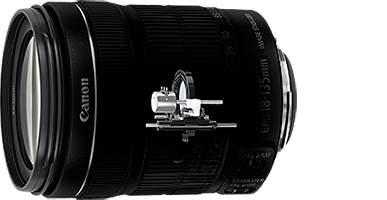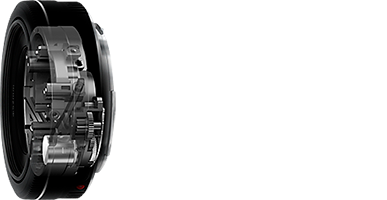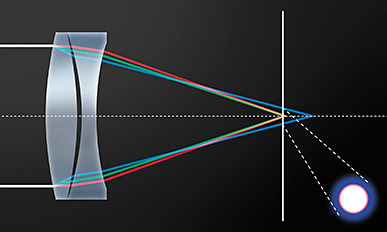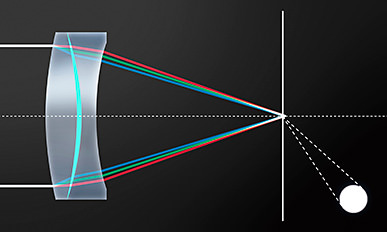2011-2015
Canon Enters the World of Filmmaking
Introduced in 2008, the Canon EOS 5D Mark II digital SLR camera featured a Full HD movie-recording function1 (EOS Movie) that garnered attention among professionals working in the cinema and video production industries. Canon, recognizing the tremendous potential that the technology offered filmmakers and cinematographers, launched a companywide effort to develop the Cinema EOS System, a new lineup of digital cinematography cameras and lenses, marking its full-fledged entry into the motion picture production industry. With competition getting fiercer in the high-definition expression of still images and movies, Canon continues to actively launch attractive new products.
1 It was the world’s first digital SLR camera to be equipped with a Full HD movie recording function
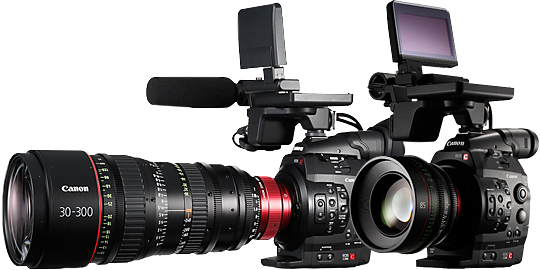
EOS Movie Wins Kudos from Hollywood
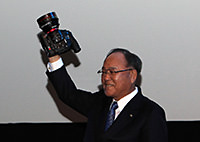
Canon Inc. Chairman and CEO Fujio Mitarai holds aloft a Cinema EOS camera at the press conference for the launch of the Cinema EOS System.
The EOS 5D Mark II, equipped with a Full HD movie-recording function (EOS Movie), fulfilled a range of needs that had not even been anticipated when the camera was under development. When paired with a large-aperture Canon EF lens, the 5D Mark II’s 35mm full-frame CMOS sensor enabled the capture of movie footage of a quality that surpassed that of large and costly dedicated motion-picture cameras. Industry professionals were intrigued by the benefits that the camera offered, including the ability to capture movies with a shallow depth of field, the wide range of imaging expression made possible by Canon’s diverse array of interchangeable lenses, and exceptional image quality with very little noise even when shooting at a high ISO setting. As a result, the EOS 5D Mark II earned rave reviews from Hollywood, the heart of the world’s movie capital.
Noticing the buzz the camera was generating among moviemakers, Canon U.S.A. thoroughly investigated what was happening in Hollywood. At the same time, both Canon’s video camcorder division, which was exploring new technologies to develop, as it does approximately every 10 years, and the broadcast equipment lens division, which was aiming to expand its business, had also separately set their sights on the cinema segment.
In March 2009, a meeting was convened, attended by members from the video camcorder division, the broadcast equipment lens division and Canon U.S.A., to discuss the possibility of expanding EOS Movie technology to video camcorders. Targeting the commercialization of a new line of products, Canon launched a tentative project in November of the same year, commencing activities as part of a cross-divisional endeavor aimed at breaking into the world of cinema.
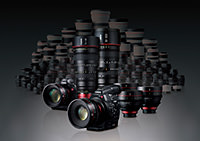
During the development phase, the decision was made to incorporate a lineup of dedicated EF Cinema Lenses within the Cinema EOS System. In 2012, the System was recognized with an iF Product Design Award.
At last, on November 4, 2011, Canon announced the introduction of the Cinema EOS System with the launch of its first Full HD digital cinema camera and dedicated cinema lenses, which went on sale on January 31, 2012. Lauded by the spirited directors that shot the promotional demo movies using the new Canon cinema camera and lenses, the Cinema EOS System marked Canon’s full-fledged entry into the professional cinema production industry and ushered in a new era throughout the motion picture industry.
The Cinema EOS System was designed to support the capture of high-definition movies in 4K resolution, which is equivalent to four times the detail realized by Full HD. Another advantage of this cutting-edge system is its compatibility with Canon’s existing EF lens lineup. Speaking at the press conference for the launch of the Cinema EOS System, held in Hollywood, California, Canon Inc. Chairman and CEO Fujio Mitarai suggested the advent of a new era, saying, “We called on the advanced technologies, the know-how, and the manufacturing skills that we have cultivated over Canon’s almost 75-year history, which offer the potential to revolutionize storytelling through motion pictures.”
Canon’s Longstanding Relationship with Hollywood
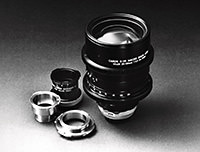
The Canon K5x25 macro zoom lens and the K-35 series were presented the Scientific and Technical Award presented by the Academy of Motion Picture Arts and Sciences.
Canon’s initial entry into the world of motion pictures dates all the way back to an era when not a single one of the other industry camera lens manufacturers were actively targeting the development of cinema lenses. In late 1969, several Hollywood filmmakers paid a visit to Canon to request that the company produce a cinema zoom lens. Upon accepting the request, optical designers Jiro Mukai and Takamasa Hirose led Canon’s development effort and in May 1971, the K5x25 macro zoom lens was born. Promptly garnering favorable reviews from filmmakers, in 1973 the lens earned Canon a Scientific and Technical Award from the Academy of Motion Picture Arts and Sciences.
A Mere Two Years from Planning to Launch
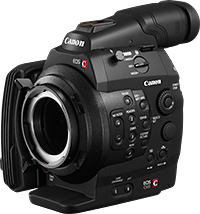
In 2013, a Canon EOS C500 PL digital cinema camera contributed to the world’s first successful capture of video of the Comet ISON from the International Space Station.
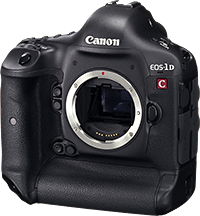
The EOS-1D C was the first digital SLR camera to satisfy the European Broadcast Union’s (EBU) standards for HD content acquisition. The camera also won a TIPA Award in 2013.
Mr. Hiroo Edakubo, who played a key role in the development of the Cinema EOS System, noted that it was a rarity for both the company’s business divisions and sales companies to achieve sales success in such a short period of time while focusing their efforts on a common goal. Based on a vision of “contributing to the creation of a new video culture” under the slogan “Aiming for Hollywood,” three separate Canon entities—the video camcorder division, the broadcasting lens division and Canon U.S.A.—pooled their energies to meet the challenge.
Filmmaking in Hollywood generally involves the use of several cameras—one large-scale main camera and multiple sub cameras, a combination that makes possible the range of camerawork required in cinema production. In other words, there was demand on sets and locations for compact cameras that offer versatility and mobility when shooting in confined spaces and from various angles.
In order to share this brand-new product concept, Mr. Edakubo first created a mockup. While it was an unusual move to create a mockup before deciding on the camera’s internal layout, Mr. Edakubo decided to do so to ensure the success of the overall project by gaining consensus on the direction of the new product among all the project members. The new cinema camera’s unconventional vertically elongated body design, which enabled easy operation and handling, proved immediately persuasive to all who saw it.
At the time that the product concept was finalized, it had already been decided that the new digital cinema cameras and lenses would be introduced as part of a combined lineup, and that the launch event would be held in Hollywood in November 2011. It was a strategy that had been thoroughly researched in advance. Needless to say, there could be no delays in development. It was against this backdrop that the entire project, which normally would have required three or more years, was completed in just two years.
The following year, in 2012, Canon successively released the EOS C500/C500 PL digital cinema cameras and EOS-1D C digital SLR camera. Featuring an ultra-high ISO speed and 4K resolution, the EOS C500 PL became the first camera in the world to successfully capture Comet ISON.
Professionals Weigh In on the Cinema EOS System
Compared with existing systems used for filmmaking, the Cinema EOS System is far more affordable yet offers exceptional shooting versatility. Its lightweight and compact body design enables increased flexibility when choosing shooting locations and angles. Also, because mounting the camera requires no major preparation, the Cinema EOS System facilitates a wide variety of cinematic techniques, including shooting from the backseat of a car or other confined space, as well high-impact low-angle shots, such as those made possible by attaching the camera to a motorcycle. Furthermore, the cameras’ high-sensitivity imaging performance does away with the need for additional lighting during shooting. This means that both lighting equipment and film crew staff can be kept to a minimum. Another benefit for users is that existing EF lenses can be used with the Cinema EOS System, enabling the capture of footage that had not previously been possible.
“Canon really contributed to my bottom line. With the Cinema EOS System, I can shoot in two days what would’ve previously required three days, which means less time that I need to secure actors and staff. If I use Cinema EOS on three shoots, I can recover my initial investment costs.” This comment, just one of the many voiced by filmmakers working on the industry’s frontlines, was welcomed by the development team as the highest form of praise.
CMOS Sensor: Key Component of the Cinema EOS System
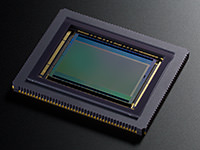
The AF system developed for the Cinema EOS System was later introduced in EOS digital SLR cameras as Dual Pixel CMOS AF.
A key component that contributed to the successful development of the Cinema EOS System in just two years was the CMOS sensor, which, in 2010, supported the realization of 4K resolution imaging.
Although manual focusing was the norm for motion picture filming, the CMOS sensor technology led to the idea to employ AF (autofocusing), which later became Dual Pixel CMOS AF. Due to the high level of definition of 4K, even the slightest discrepancies in focus are noticeable. Accordingly, this technological breakthrough was made possible through development efforts that anticipated the importance of high-precision AF.
Aside from the specs ascribed to the sensor, such foresight can also be found in many aspects of the elemental devices it employs. Testing carried out during the development stage verified the sensor’s superb performance capabilities, which was another reason why Canon was eager to commercialize its Cinema EOS System.
Faster AF Performance Realized through Dual Pixel CMOS AF
In 2013, Canon succeeded in developing Dual Pixel CMOS AF, an autofocus technology that delivers significantly improved AF performance, debuting it in the EOS 70D digital SLR camera. It makes possible high-speed, high-precision AF during Live View shooting and smooth, high-performance focus tracking when shooting movies. Developed in-house by Canon, Dual Pixel COMS AF is an innovative technology that integrates Canon-manufactured CMOS sensor technologies with the AF technologies that the company has developed over the years. Born at the same time as the Cinema EOS System, Dual Pixel CMOS AF could be viewed as a symbol of the forward-looking spirit that guides Canon’s development efforts, which are always firmly focused on what lies ahead.
Dual Pixel CMOS AF
Winning Over New Users with the EOS M Series

The EOS M, which features a refined touch-screen user interface, won an iF Design Award in 2012.
In addition to the Cinema EOS System, which rocked the industry beyond that of digital SLR cameras, Canon was striving to share its vision of the realm of digital imaging with a wider audience.
At the time, a number of mirrorless cameras, which did away with the mirror mechanism employed in digital SLR cameras to realize smaller body dimensions, were introduced by competing camera manufacturers, a development that led to the continued expansion of the user base for interchangeable-lens cameras.
Although a latecomer to the mirrorless camera market, Canon turned the release the EOS M series to its advantage by making use of a large APS-C-size CMOS sensor comparable in size to those found in digital SLR cameras, which excels in image quality compared with competing products that employ smaller CMOS sensors.
The EOS M series, which inherited the DNA of Canon’s digital SLR cameras, succeeded in winning over smartphone and compact digital camera users with its stylish appearance and touch-screen user interface. Following the debut of the EOS M in 2012, Canon’s EOS M series lineup expanded with the release of the EOS M2 in 2013, followed by the EOS M3 and the EOS M10 in 2015, along with the introduction of new dedicated EF-M lenses.
Evolution of Digital Compact Cameras
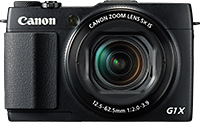
The high-end PowerShot G1 X Mark II digital compact camera is equipped with a 1.5-inch CMOS sensor and an f/2-3.9 lens.
It was during this same period that smartphones enjoyed explosive popularity as a tool for image communication. Equipped with a camera function that progressively offered higher levels of imaging performance, the proliferation of smartphones led some to question the continued need for digital compact cameras.
Despite such adverse circumstances, Canon continued to respond flexibly to new user needs for digital compact cameras. Based on the view that a camera is, inherently, a camera, Canon further enhanced its digital compact camera lineup with new models featuring a large-sized image sensor or high-magnification zoom lens.
The goal behind this approach was not to compete with smartphones, but rather to coexist with them, which naturally led to the inclusion of Wi-Fi capabilities and smartphone apps.
Surpassing the 50-megapixel Threshold
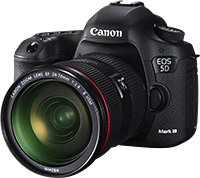
The EOS 5D Mark III is lavishly packed with technologies to enhance image quality at high ISO speeds. It also features a 61-point High Density Reticular AF, the same as that on the EOS-1D X, as well as an expanded ISO speed range from ISO 50 to 102400. The EOS 5D Mark III won both a TIPA Award and EISA Award in 2012.
Meanwhile, Canon continued to enhance its lineup of high-end digital SLR cameras. In March 2012, the company launched the EOS-1D X, which merged the high-pixel-count imaging performance of its EOS 1Ds series with the fast continuous-shooting capabilities of the 1D series, and the EOS 5D Mark III, successor to the EOS 5D Mark II, which built a loyal following among advanced-amateur and professional users. Other innovative series releases included the EOS 6D (launched in November 2012), a compact, lightweight model that was the first EOS-series camera with built-in Wi-Fi connectivity; and the EOS 7D Mark II (November 2014), with a maximum continuous shooting speed of approximately 10 frames per second (fps) and high-performance AF.
In June 2015, Canon released the EOS 5DS and the EOS 5DS R, cameras boasting an effective pixel count of more than 50 megapixels. Both models feature an approximately 50.6-million-pixel 35mm full-frame CMOS sensor that outperforms the imaging capabilities of competing products. The cameras also incorporate Dual DIGIC 6 image processors which, despite the high pixel count, facilitate high-speed continuous shooting of up to approximately 5.0 fps and a maximum standard ISO of 6400. Maximizing the benefits of the high-resolution image sensor, the EOS 5DS and 5DS R employ a cam-driven mirror vibration control system that reduces camera-shake blur, and include a new “Fine Detail” Picture Style mode that prioritizes the depiction of subtle image details.
The Ongoing Evolution of EF Lenses
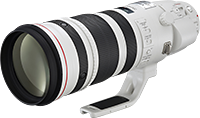
The EF200-400mm f/4L IS USM Extender 1.4x is the world’s first super telephoto zoom lens with a built-in extender.
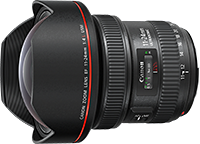
Boasting the world’s widest angle of view with a focal length of 11mm, the EF11-24mm f/4L USM enables all-new possibilities in ultra-wide-angle photographic expression. The lens won a TIPA Award in 2015.
Canon’s wide array of EF interchangeable lenses also continue to evolve. Since passing the 70-million-unit mark in 2011, cumulative production has steadily grown, reaching 80 million units in 2012 and surpassing the 100-million threshold in 2014. The 100 millionth EF lens to roll off the production line was an EF200-400mm f/4L IS USM Extender 1.4x, the world’s first super-telephoto zoom lens with a built-in extender.
Creating the world’s first super-telephoto zoom lens to incorporate an internal extender was a process beset by numerous challenges, but Canon’s earlier success in developing a broadcast lens with a built-in extender proved a valuable experience. The mechanical design of the lens was subject to a thorough review, including such aspects as the shape, durability and the positioning of the actuator. The EF200-400mm f/4L IS USM Extender 1.4x lets users change the zoom range from 200-400mm (maximum aperture of f/4) to 280-560mm (maximum aperture of f/5.6) without having to switch lenses while suppressing chromatic aberration throughout the entire zoom range to achieve a level of imaging performance comparable to that of prime lenses.
In 2015, Canon released the EF11-24mm f/4L USM ultra-wide-angle zoom lens, which boasts the world’s widest angle of view. It is also Canon’s first EF lens to simultaneously make use of two coating technologies: Air Sphere Coating (ASC), which exhibits exceptional anti-reflective properties for incident light that enters the lens at an almost vertical angle, and Subwavelength Structure Coating (SWC), which reduces the reflection of light with a large angle of incidence. Additionally, through the effective arrangement of its four aspherical lens elements, the EF11-24mm f/4L USM corrects for a range of aberrations frequently associated with ultra-wide-angle lenses.
Subwavelength Structure Coating (SWC)
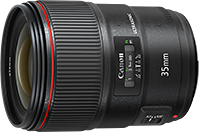
The EF35mm f/1.4L II USM BR is the first lens to employ a BR lens, capable of significantly reducing chromatic aberration while realizing superlative rendering performance from the center to the peripheral areas of the image field.
Following the advent of the EOS 5DS and EOS 5DS R, new designs were adopted for EF lenses to bring out the resolving power of 50-megapixel cameras and lens technologies have continued to evolve in step with advances in camera technology. Some of the latest technologies introduced include a Stepping Motor (STM) that supports smooth and quiet operating performance, and a Blue Spectrum Refractive (BR) lens capable of refracting blue (short wavelength) light to deliver impressive levels of chromatic aberration correction.



